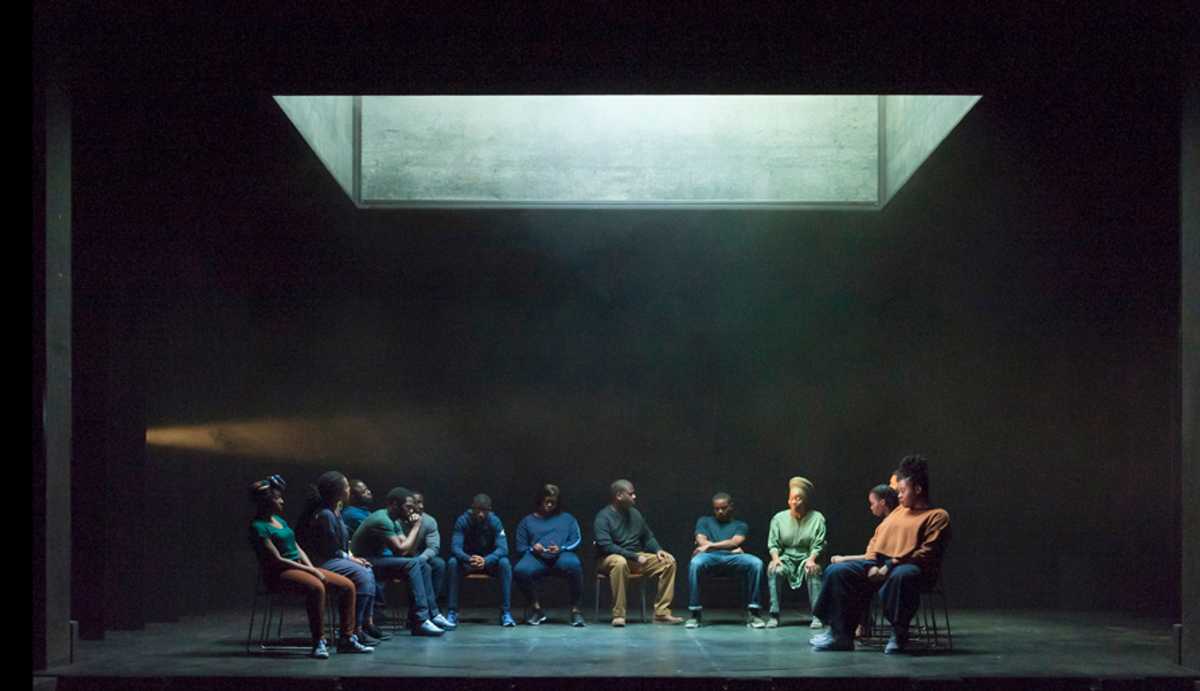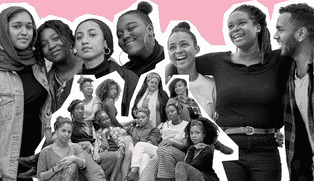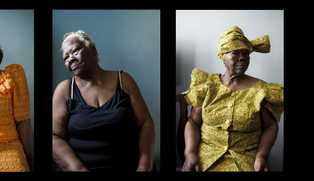It’s a cold November afternoon in London and I am nervous. A week ago, I saw ear for eye, debbie tucker green’s explosive new play at The Royal Court. Today I am meeting Kayla Meikle, the actor who delivered, arguably, its most resonant and climactic monologue.
Onstage, Meikle is a force. She plays an intelligent African American teenager whose love of science and maths, and knack for logical thinking, help make the play’s biggest ideas devastatingly clear. She talks about “numbers and equations”, “rudimentals and fundamentals”, about “breakin’ shit down” and “workin’ shit out.” Meikle’s Young Woman thinks of the world through systems of logic, structure and design.
And this, really, is what the play is most concerned with: systems of logic, structures, and what they are designed to do. ear for eye is a dissection of anti-black racism, a three-part examination of its inescapable hegemony, and our attempts as black people to survive it. For over two hours, the audience experiences its building tension with very little release. The play is a consuming aggregation of many of our lived experiences. I ask Meikle how she approaches this intensity this day after day onstage.
“One thing about black people is, and it comes from a really sad place, but wherever we go we’ve got this spirit about us. We create happiness. So even though we are doing such a heavy play, the rehearsal room was actually a fun, banterous place. debbie is all about banter.”
She stops for a moment, then adds, “and debbie’s work is all about the words. It’s about the grammar, the punctuation. Focusing on where a line is cutting off, or where someone is interrupting you, actually takes a bit of the pressure off carrying this heaviness for the characters. It’s helpful.”
debbie tucker green’s masterful deployment of verse, even with it’s jarring content, is oddly comforting to hear. Characters’ lines fit next to, on top of, around each other, with almost systematic precision.
In part one, we witness a collection of moments, families, friends, individuals, communities trying to make sense of the inescapable hegemony. These scenes offer up conflicting ideas on action and protest. A mother and son lob fragmented sentences back and forth in a futile attempt to grasp what exactly it is he should do with his hands in the presence of police. A father and son struggle toward an inevitable disagreement on how best to channel the anger that results from injustice. Two friends criss-cross disparate perspectives on what warrants true and valuable protest. Angry young people valorise ‘the pain of being right.’ These characters grasp for answers on how to exist within a system in which black terror, trauma, and death are inherent. In every corner, at every turn, no matter what you do, no matter what you wear, whether you are Black British or African American, whether you are young or old, ear for eye shows us that this racism, and our need to address it, is inescapable.
“It’s relentless,” Meikle interjects.
 Offstage, Kayla Meikle is still a force. Her voice is measured and confident, her presence undeniable. She is also extremely easy to talk to. I am eager to hear everything about debbie tucker green’s banter, about what it was like to be in a double digit cast of, bar one, entirely black actors.
“I wish I could have seen this as a teenager,” Meikle muses, “to see this character talking to me onstage.”
Meikle’s Young Woman in ear for eye was me, and so many other black women I know. She is precocious and confident. She is fully aware of her capacity for brilliance and she revels in it. Though her character introduces herself to us through a haze of adolescent glee, she soon feels the weight of the society she’s inherited. Merle Hansen’s sleek and minimal design captures this in the large ominous box looming above the action.
“[That] big box of doom hanging above our heads getting lower, and lower, and lower. Suppressed as fuck.”
Relentless. What Meikle’s Young Woman does, though, is remind us that systematic racism is more than just relentless. Her monologue starts with self-aggrandizement: “Lemme say it again premier, primero… top of the damn class!” She is smart and she knows it.
“It’s just so rare to see young women characters who are not ashamed about how clever they are,” Meikle gushes.
She won’t bring home any grade less than she is capable of and she has her “head in books steada in the clouds.” In fact, she knows exactly what ‘the clouds’ are made up of. She knew before she saw and felt those clouds above her as she and her community marched and chanted at a protest. At this protest, she hears a ‘flashbang’ and,
‘anythin else said is unhearable
momentarily blinded by a light that aint holy
ears ringing in an impossible silence that
sets you wonderin if this is what deaf
sounds like…’
But it doesn’t stop, another ‘flashbang,’
‘Deliberate.
I see – kicking out from its canister, then
driftin like iss casual but it ain’t – the light
Milky-white-cloud
drifting up and out.
deliberate.
Deliberately done. By them.’
“There is a line in the monologue where she says: ‘like this is designed to, like it’s all meant to. It’s deliberate.’ And from the moment I read that… I just keep thinking about that line. Because for me, that is what the play is about.”
Offstage, Kayla Meikle is still a force. Her voice is measured and confident, her presence undeniable. She is also extremely easy to talk to. I am eager to hear everything about debbie tucker green’s banter, about what it was like to be in a double digit cast of, bar one, entirely black actors.
“I wish I could have seen this as a teenager,” Meikle muses, “to see this character talking to me onstage.”
Meikle’s Young Woman in ear for eye was me, and so many other black women I know. She is precocious and confident. She is fully aware of her capacity for brilliance and she revels in it. Though her character introduces herself to us through a haze of adolescent glee, she soon feels the weight of the society she’s inherited. Merle Hansen’s sleek and minimal design captures this in the large ominous box looming above the action.
“[That] big box of doom hanging above our heads getting lower, and lower, and lower. Suppressed as fuck.”
Relentless. What Meikle’s Young Woman does, though, is remind us that systematic racism is more than just relentless. Her monologue starts with self-aggrandizement: “Lemme say it again premier, primero… top of the damn class!” She is smart and she knows it.
“It’s just so rare to see young women characters who are not ashamed about how clever they are,” Meikle gushes.
She won’t bring home any grade less than she is capable of and she has her “head in books steada in the clouds.” In fact, she knows exactly what ‘the clouds’ are made up of. She knew before she saw and felt those clouds above her as she and her community marched and chanted at a protest. At this protest, she hears a ‘flashbang’ and,
‘anythin else said is unhearable
momentarily blinded by a light that aint holy
ears ringing in an impossible silence that
sets you wonderin if this is what deaf
sounds like…’
But it doesn’t stop, another ‘flashbang,’
‘Deliberate.
I see – kicking out from its canister, then
driftin like iss casual but it ain’t – the light
Milky-white-cloud
drifting up and out.
deliberate.
Deliberately done. By them.’
“There is a line in the monologue where she says: ‘like this is designed to, like it’s all meant to. It’s deliberate.’ And from the moment I read that… I just keep thinking about that line. Because for me, that is what the play is about.”
 Meikle’s Young Woman goes on to intricately describe the intense pain of the milky-white cloud, of more flashbangs and ‘Black bodies staggering into each other.’ She names the cloud: tear gas, and confidently states its scientific name, just in case we forget that she knows what she is talking about. Meikle’s performance is captivating. Breathtaking. She moves about the stage, enclosed by a semicircle of her fellow students, first talking to them, then educating them, for she is now a child forced to make the realisations of an adult.
“I think debbie definitely has done something really special with the character of the young student.”
There is such a power, I say to Meikle, in making such realisations as a young person.
“Yes. There’s a sadness to it, such a sadness. She starts off so positive and funny. You think you know what you’re getting, maybe a little bit of light relief, but the sad reality of it is that you are watching this character who knows they are fucked. Who knows how fucked it all is.”
We pause. And then we laugh pitifully.
“We gotta laugh or we’ll cry.”
Meikle’s Young Woman goes on to intricately describe the intense pain of the milky-white cloud, of more flashbangs and ‘Black bodies staggering into each other.’ She names the cloud: tear gas, and confidently states its scientific name, just in case we forget that she knows what she is talking about. Meikle’s performance is captivating. Breathtaking. She moves about the stage, enclosed by a semicircle of her fellow students, first talking to them, then educating them, for she is now a child forced to make the realisations of an adult.
“I think debbie definitely has done something really special with the character of the young student.”
There is such a power, I say to Meikle, in making such realisations as a young person.
“Yes. There’s a sadness to it, such a sadness. She starts off so positive and funny. You think you know what you’re getting, maybe a little bit of light relief, but the sad reality of it is that you are watching this character who knows they are fucked. Who knows how fucked it all is.”
We pause. And then we laugh pitifully.
“We gotta laugh or we’ll cry.”
*
Meikle, along with most of the cast, does not feature in part two or three of the play. Part two is a series of frustrations on identity, power and classification between an black American woman and a white American man. No summation is adequate; it must be seen. Part three is a formal departure from the rest of ear for eye. It provides contextual grounding for everything that came before it, a definitive conclusion on the deliberate design of racism that features only white speakers. “All of these things that [the characters in part two and three] are talking about, these stories, our experiences, they’re not a coincidence. They’re not an accident. This world that we live in is designed and set up for us to fail. That’s it. That’s it from start to finish.” In parts one and two, black characters try to address racism’s inescapable hegemony and their attempts are frustrated and futile, because they do not have control of the structure looming above and around them. They did not create it. Part three turns the gaze onto the inheritors of those who did, and serves as a reminder to them that in the face of a generations-old, system of terror, the very least, the absolute minimum, we deserve is your ear.
*
My conversation with Meikle is coming to an end, but we hadn’t really delved into the play’s dramatic concern: action. ear for eye cares about what we do and how we decide to do it, even if we are thwarted, even if we disagree. It is about taking active steps to continue surviving. Determining what kind of action is sufficient can be hard in the face of deliberate, relentless racism, particularly for young people. I ask Meikle what she would tell her fifteen year old self right now. “Listen, just believe in yourself 100%. Back yourself to the end, fully. Trust your gut. Because what is for you won’t go by you. Is that really cringy? Does everyone say that?” It’s not, and perhaps they do, but it is still important. “Because of the way I look, because I am fat and I am black, I’m funny and I look a little bit weird and geeky, I really, really didn’t feel like there was a space for me in this world. And I just wish I didn’t waste so much time thinking that, you know? Because there really is, there really is a space for me and for us. And I’m taking it. We’re taking it.” My final question, in honour of our latest Skin Deep print issues on Movements, I ask: what do you think is a vital movement? It is purposefully open-ended question. Meikle thinks for a while. “I was born and raised in London so London is all I know. I do feel like there is now a change in the air here. I can only speak of my experience as a black woman, but I feel that our voices are finally being fucking heard. I’ve never felt so confident in my own skin in taking up space, whether it be on a stage, or just walking into a room. I hope that other black women share that with me in London. And everywhere.” You can catch debbie tucker green’s play ear for eye at the Royal Court until 24th November 2018. Tickets here.



